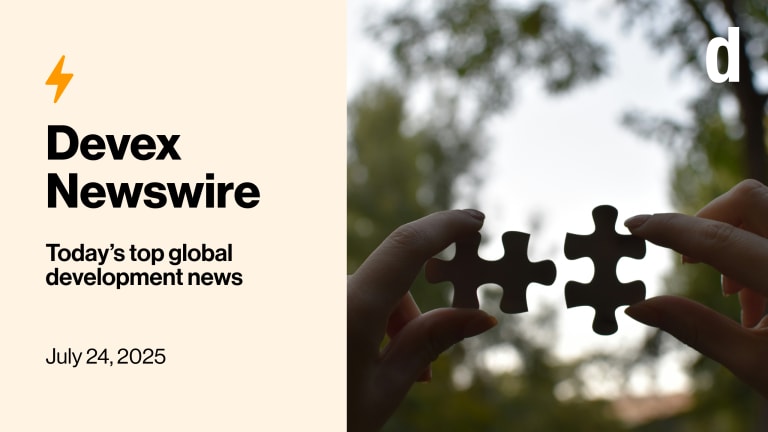Exclusive: Global health giants partner up under new umbrella
Beginning next January, HealthX Partners will control a combined budget of nearly half a billion dollars.
Population Services International and the Elizabeth Glaser Pediatric AIDS Foundation are coming together under a new umbrella group, HealthX Partners — a parent company which, beginning next January, will control a combined budget of nearly half a billion dollars. Both PSI and EGPAF will continue to operate independently, retaining their names, brands, and missions — but they will be subsidiaries to HealthX Partners. While technical and programmatic staff will remain at PSI and EGPAF, ultimately, the two organizations will share back-office functions at the HealthX Partners level, such as human resources, accounting, and finance. The HealthX board will have final decision-making power. Through this new structure, PSI and EGPAF are hoping to streamline their operations while providing a more connected, comprehensive set of services. “Given all the dynamics in the sector, the worst thing for any organization to do right now is nothing,” Karl Hofmann, PSI’s current president and chief executive officer, told Devex. “We think a transnational, networked approach is a smart way to deliver value.” Founded in 1970, the Washington, D.C.-based PSI provides health care products and services with a focus on reproductive health, family planning, malaria, tuberculosis, and HIV/AIDS. Today, it has 2,600 staff members. EGPAF — which is also based in Washington, D.C. — has centered on ending HIV/AIDS in children since its formation in 1988, and currently employs nearly 1,600. “It’s not a merger, because [the EGPAF and PSI] identities are really important,” said Chip Lyons, the current president and chief executive officer of EGPAF. “It’s on purpose that it’s a parent organization with subsidiaries as co-creators, and additional subsidiaries that may find [a partnership] beneficial given the challenges that they’re facing.” Hofmann will lead PSI until a successor is named in the coming months — and once that happens, he will transition to leading HealthX Partners. Lyons will be retiring once his replacement is secured early next year. It marks the end of more than 15 years at PSI and EGPAF for Hofmann and Lyons respectively, and a new chapter for the decades-old organizations. “I think over the next five years, those that are going to be able to move forward with their missions and their objectives are those that are going to be more creative, and more innovative in recognizing the external circumstances,” Lyons told Devex. Though Lyons and Hofmann said their organizations are far from financial distress, they did recognize the challenges. PSI’s revenue is down by more than 40% since its high point in 2015, while EGPAF’s revenue has been reduced by 15% from its high point in 2019 to 2022, the last filing year available. The organizations are far from alone: across the global health sector, things are changing. A new analysis from the ONE Campaign found that when COVID-19 money is stripped from official development assistance, nearly every major donor is trending down with its health financing. And looking ahead, there seems to be even more of that to come. The European Union, France, Germany, and the United States slashed official development spending by nearly $9 billion this year alone, with further cuts planned in France and Germany in 2025, according to ONE. “Health ODA was declining before COVID-19 hit. During COVID we saw this huge surge, and we were all focused there — but it was disguising this ongoing trend,” Jenny Ottenhoff, ONE’s senior policy director of global health, told Devex. “I feel like the entire sector is spinning its wheels a little bit, and that concerns me.” On top of that, Hofmann described how a “sizable chunk” of PSI’s budget is now going toward at least 10 local entities that PSI has helped spin off the larger international organization. PSI Zimbabwe and PSI Malawi, for example, have grown into organizations of their own — splitting their budgets from the larger PSI to become Population Solutions for Health in Zimbabwe and Family Health Solutions in Malawi. “They’re good at what they do. So logically, USAID and other funders look at them and say, this is a great, attractive way to ensure good quality programming with accountability, because we know these folks, but they’re independent, and they are national or local organizations,” Hofmann said. A similar trend, Lyons said, is playing out with the President’s Emergency Plan for AIDS Relief, the U.S. government’s flagship HIV program. Since 2017, PEPFAR has been pushing more money to the local organizations closest to the communities affected by HIV. USAID said that last year nearly three-fifths of its PEPFAR funding went directly to local groups, representing a 72% jump since 2018. As a result, Lyons said, the role of international nongovernmental organizations is shifting away from direct, large-scale service delivery. “That, in more and more countries, is the responsibility of national and local partners,” Lyons said. “As it should be.” Still, that doesn’t mean PSI and EGPAF will halt their operations. In some countries, Lyons explained, service delivery will continue due to the conditions, relationships, and context on the ground. But in many others, PSI and EGPAF will be exploring ways to integrate their programs to address a wide range of needs in communities — connecting a teen who received pediatric HIV/AIDS support from EGPAF, for example, to contraceptive services from PSI. While current projects won’t be affected by the shift, PSI and EGPAF will be looking toward future initiatives to link their programs together. “There’s a logical synergy, and we know we’re constrained by vertical funding, but we can’t be constrained by that in terms of thinking how to deliver value to the consumers, and the people we serve, and the health systems,” Hofmann added. It’s a change that will eventually involve redundancies, though neither PSI nor EGPAF could provide the exact number of layoffs to come. The first changes, Hofmann explained, will be at the governance level: The boards of PSI and EGPAF will shrink and merge, making some adjustments within their ranks to do so. The current board chairs of each organization — EGPAF’s Jack Leslie and PSI’s Carolyn Brehm — will serve as the co-chairs of HealthX Partners. PSI and EGPAF will also have their own small boards with “measured independence,” according to Hofmann. Hofmann described the initial HealthX Partners team as a “thin corporate crust,” and in the initial phases of the rollout, employees will be detailed to HealthX Partners from either EGPAF or PSI. While each entity will prepare its own budget, HealthX Partners has the ultimate approval authority and services will be shared between entities “based on fairly and transparently costed pricing,” according to the organizations. In time, HealthX Partners — which will be based in Washington, D.C., but registered in Delaware — hopes to bring other organizations into the mix. That includes PSI’s commercial subsidiary, Viya Health, along with other organizations in the global health space. Those groups don’t necessarily need to focus on HIV/AIDS, Hofmann said, and noted the importance of looking at both health systems and climate change’s impact on health. “I think we need to look broadly,” Hofmann said. “We need to have our blinders wide open, our apertures wide open to look at what we can do.” <iframe width="100%" height="166" scrolling="no" frameborder="no" allow="autoplay" src="https://w.soundcloud.com/player/?url=https%3A//api.soundcloud.com/tracks/1932386366%3Fsecret_token%3Ds-n3fCdWoIUr8&color=%23ff5500&auto_play=false&hide_related=false&show_comments=true&show_user=true&show_reposts=false&show_teaser=true"></iframe><div style="font-size: 10px; color: #CCCCCC;line-break: anywhere;word-break: normal;overflow: hidden;white-space: nowrap;text-overflow: ellipsis; font-family: Interstate,Lucida Grande,Lucida Sans Unicode,Lucida Sans,Garuda,Verdana,Tahoma,sans-serif;font-weight: 100;"><a href="https://soundcloud.com/devex-intl" title="Devex" target="_blank" style="color: #CCCCCC; text-decoration: none;">Devex</a> · <a href="https://soundcloud.com/devex-intl/exclusive-global-health-giants-partner-up-under-new-umbrella/s-n3fCdWoIUr8" title="Exclusive: Global health giants partner up under new umbrella" target="_blank" style="color: #CCCCCC; text-decoration: none;">Exclusive: Global health giants partner up under new umbrella</a></div> Listen to our exclusive interview with PSI’s Karl Hofmann and EGPAF’s Chip Lyons on the two organizations’ new umbrella group, HealthX Partners. Via SoundCloud.
Population Services International and the Elizabeth Glaser Pediatric AIDS Foundation are coming together under a new umbrella group, HealthX Partners — a parent company which, beginning next January, will control a combined budget of nearly half a billion dollars.
Both PSI and EGPAF will continue to operate independently, retaining their names, brands, and missions — but they will be subsidiaries to HealthX Partners. While technical and programmatic staff will remain at PSI and EGPAF, ultimately, the two organizations will share back-office functions at the HealthX Partners level, such as human resources, accounting, and finance. The HealthX board will have final decision-making power.
Through this new structure, PSI and EGPAF are hoping to streamline their operations while providing a more connected, comprehensive set of services.
This story is forDevex Promembers
Unlock this story now with a 15-day free trial of Devex Pro.
With a Devex Pro subscription you'll get access to deeper analysis and exclusive insights from our reporters and analysts.
Start my free trialRequest a group subscription Printing articles to share with others is a breach of our terms and conditions and copyright policy. Please use the sharing options on the left side of the article. Devex Pro members may share up to 10 articles per month using the Pro share tool ( ).
Elissa Miolene reports on USAID and the U.S. government at Devex. She previously covered education at The San Jose Mercury News, and has written for outlets like The Wall Street Journal, San Francisco Chronicle, Washingtonian magazine, among others. Before shifting to journalism, Elissa led communications for humanitarian agencies in the United States, East Africa, and South Asia.








